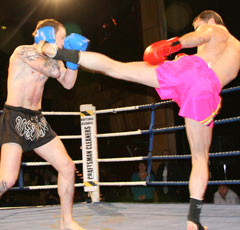KARATE-LIKE KUNGFU

Using high kicks like this kick-boxer does is not encouraged in the type of Shaolin Kungfu practiced in our school. The picture above is reproduced from http://www.prokick.com/archive/news/2007/Sept/Pictures&Results.html
Question
The teacher has had a lot of karate experience and it seems a little karate-like in its nature. For instance in your book you say that kicks in kung fu rarely go above the waist. I have been taught kicks that go above the waist to the head.
— Iain, Scotland
Answer
In the last thirty years or so, there were many kungfu masters who could not use kungfu to fight, and therefore they incorporated karate into their kungfu sparring. Often they invented a new name for their kungfu styles which frequently ended in the word “do” (or “tao” in Chinese), taking inspiration from the “do” in karate-do and taekwondo.
Some of these masters were sincere in their effort. They lamented on the inability of kungfu for combat and they tried their best to do something about it. (Here I am using the words “kungfu” and “masters” in the way the public generally uses it.)
Such kungfu-do was (and still is) superior to kungfu dance, and many kungfu dance practitioners held kungfu-do practitioners in awe. In sparring, one who has practised kungfu dance for many years is no match at all against another who has practised kungfu-do for only a few months.
This is actually no surprise. If you only learn how to dance or demonstrate to audience, you will only be able to dance or demonstrate; you will never know how to spar no matter for how long you have danced. On the other hand, if you learn sparring you will be able to spar after a few months, even though you may not spar very well.
Kungfu-do inventors thought they had improved kungfu, but paradoxically they had further debased it. Because of their insufficient understanding, they used (from genuine kungfu perspective) third-class techniques, thinking they were first-class. Instead of attaining good health, their students often sustained internal injury routinely left unattended to.
And there was little or no internal force training or spiritual cultivation. I recall my master, Sifu Ho Fatt Nam, often commented that kungfu-do was turning kungfu into “sei pat jeong”, a Chinese colloquial way of saying “turning a cow into a horse, or a horse into a cow”.
Often kungfu-do practitioners are better at sparring than karate practitioners, but they find it difficult to defend against taekwondo practitioners. The reason generally is that kungfu-do practitioners have more hand techniques than karate practitioners have, but they do not know how to counter against the various kicks of taekwondo. Some people even thought (mistakenly) that there were no kicks in kungfu.
Consequently kicks, especially high kicks, were incorporated into kungfu-do. In fact at one time the general opinion seemed to be that the higher one could kick, the better he was in combat. Jumping up to break with his toes a tile held some distance above his head, or spinning round and round to slap the face of an opponent countless times with the sole or instep of his foot, became popular in martial art demonstrations and movie entertainment.
This is an illuminating example showing the huge gap between public opinion and genuine knowledge. Any master who has used kungfu for real fighting will know that such above-head kicks and spinning kicks are both useless and risky. If a master demonstrates such kicks, it is meant to show his leg flexibility, and not meant for combat.
On the other hand there were also instructors who were basically trained in karate or taekwondo but learned some kungfu. They incorporated kungfu techniques into their karate or taekwondo teaching, and invented new names for their styles, or sometimes they call their art kungfu or kungfu-do. But even if they wear kungfu uniforms, practise with some kungfu weapons, and talk in kungfu terms, their arts are still basically karate or taekwondo.

Shaolin kicks are generally low, as demonstrated here by Bjoern in a sparring practice with his father, Sifu Andrew Barnett
LINKS
Reproduced from Questions 8 in the December 1999 Part 1 issue of the Question-Answer Series.
